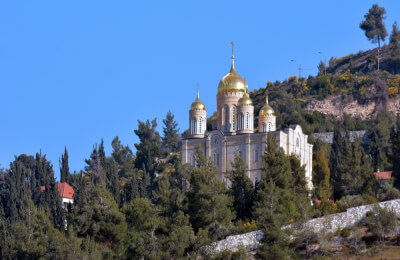
38. Orthodox shrines of Jerusalem Promotion
192. Orthodox Jerusalem Promotion
 175₪
175₪
 175₪
175₪
We also found excursions from other cities that are close to your departure city
Other excursions that also deserve your attention
Sight in Israel: The Intriguing Russian Suburbs of Jerusalem
Jerusalem, Israel's eternal capital, is a mosaic of cultures, religions, and histories, each contributing to the city's vibrant tapestry. While its ancient walls and holy sites capture much of the global attention, tucked away in its expanse lies an area rich in history but less frequented by the usual tourist crowd: the Russian Suburbs.
The Genesis of the Russian Suburbs
Situated outside the Old City walls, towards the western edge of Jerusalem, the Russian Suburbs, also known as the Russian Compound, is a large area that dates back to the 19th century. Established by the Imperial Orthodox Palestine Society, it served as a hub for Russian Christian pilgrims journeying to the Holy Land.
Interesting Fact:
The initial motivation behind the Russian Compound's establishment was to support the large number of Russian pilgrims – sometimes reaching up to 20,000 annually – who traveled to Jerusalem in the late 19th century.
Architectural Wonders and Historical Edifices
The Russian Compound boasts a series of impressive buildings and structures, each with its tale to tell. 1.
The Holy Trinity Cathedral
Dominating the skyline of the Russian Suburbs is the Holy Trinity Cathedral with its striking golden dome and ornate detailing. Built between 1860 and 1872, the cathedral stands as a testament to Russian ecclesiastical architecture and is an active place of worship to this day. 2.
The Sergei Building
Named after Grand Duke Sergei Alexandrovich of Russia, this grand edifice was initially a hostel for Russian aristocrats and notables visiting Jerusalem. Its distinctive red brickwork and arches make it a prominent landmark. Today, it has been beautifully restored and houses a luxurious boutique hotel. 3.
Pilgrim Hostels
The compound also comprises multiple hostels that once served the thousands of Russian Christian pilgrims. Their architecture provides a glimpse into the design preferences of late 19th-century Russia.
The Compound's Role in Modern Israeli History
Post World War I, with the British Mandate's establishment in Palestine, the Russian Compound took on new roles. Several of its buildings were repurposed by the British, and the area became a key administrative center.
Interesting Fact:
The central prison in the Russian Compound was where Jewish underground fighters, who opposed the British rule, were imprisoned. Today, part of this prison serves as the ""Underground Prisoners Museum,"" commemorating their struggle for an independent Jewish state.
Cultural Revival and the Modern Day
In the latter half of the 20th century, following an agreement between Israel and the Soviet Union, most of the Russian Compound was transferred to Israeli hands, save for the Holy Trinity Cathedral and a few other structures. This change led to a cultural and social revival of the area. Today, the Russian Suburbs are a bustling hub in Jerusalem, seamlessly blending history with modernity. By night, it transforms into a lively area dotted with bars, restaurants, and clubs, frequented by locals and tourists alike.
Annual Celebrations: The Jerusalem Light Festival
One of the standout events held in the Russian Compound is the annual Jerusalem Light Festival. Buildings in and around the area, including those in the Russian Suburbs, are illuminated with dazzling light installations by international artists. The juxtaposition of contemporary art forms on historical edifices provides a mesmerizing spectacle.
Conclusion
The Russian Suburbs of Jerusalem are a perfect embodiment of the city's layered histories and diverse influences. While the tales of Russian pilgrims and British officers echo through its streets, its modern-day avatar as a cultural hotspot ensures its continued relevance. For those seeking stories beyond the oft-trodden paths in Jerusalem, the Russian Compound offers a rich narrative, waiting to be explored. It stands as a testament to Jerusalem's unique ability to harmoniously blend the old with the new, the sacred with the secular.









